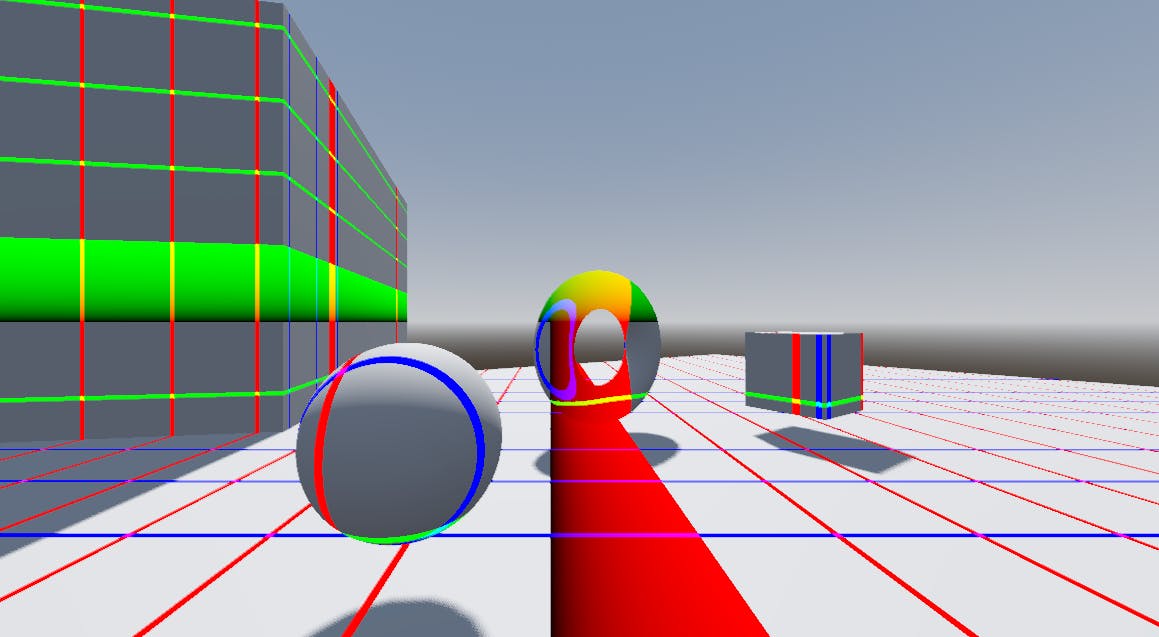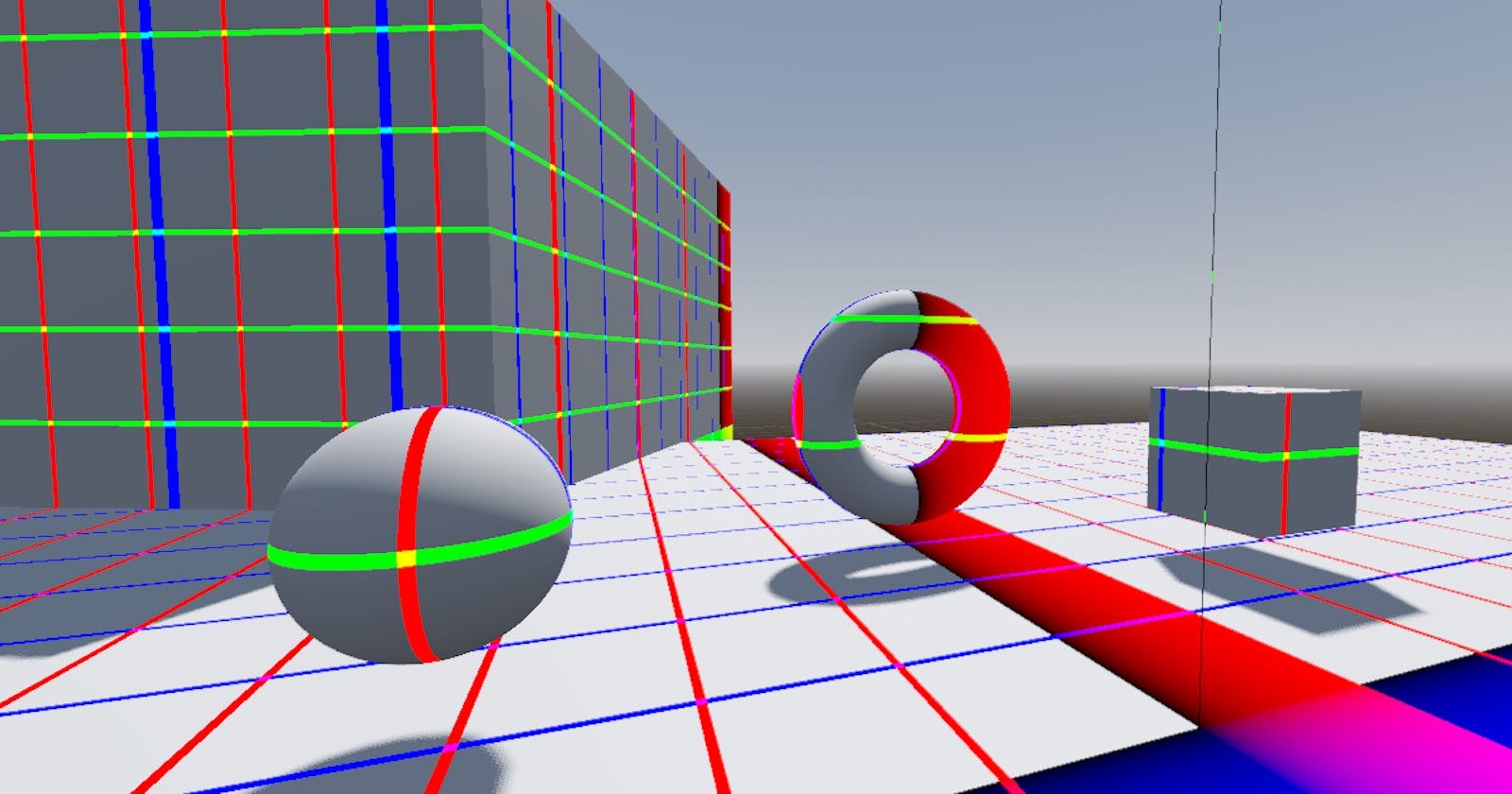I created a sample post-processing shader to illustrate some of the information that can be obtained within a post-processing shader in Godot. You can find the code here:
GitHub Repo: https://github.com/Vortex-Basis-LLC/Godot-VBG-Samples-Shaders
Specific Shader: https://github.com/Vortex-Basis-LLC/Godot-VBG-Samples-Shaders/blob/main/shaders/post_process_ref_grid.gdshader
The Post Process Ref Grid shader provides several options for overlaying a coordinate grid onto the surface of the world and visualizing other data points available within post-processing shaders (roughness, depth, distance to camera, normals). This shader can serve as a handy reference for how to access certain types of data within a post-processing shader:
Original pixel color
Original pixel roughness
Normal in view space or world space
Pixel position in view space or world space
Camera position in world space
The following image shows the world space grid overlay.

This next image has a view space grid overlay. The thicker red, green, and blue lines with gradients mark the area from 0.0 to 1.0 to make it easier to see where the origin of the axes are located.

And, here's the full source of the shader for quick reference, but I'd recommend viewing the source file on github to make sure you are seeing the latest version:
shader_type spatial;
render_mode skip_vertex_transform, unshaded;
uniform sampler2D screen_texture: hint_screen_texture, filter_nearest;
uniform sampler2D normal_texture: hint_normal_roughness_texture, filter_nearest;
uniform sampler2D depth_texture: source_color, hint_depth_texture, filter_nearest;
// grid_mode enum
// 0 = Off
// 1 = World Space Grid
// 2 = View Space Grid
uniform int grid_mode = 1;
// grid_origin indicates coordinates in chosen space where grid should originate.
uniform vec3 grid_origin = vec3(0.0);
// grid_scale indicates how many units are between each line.
uniform float grid_scale = 1.0;
// When viewing depth or distance-based modes, the pixel scolor will go from
// black to white as value goes from depth_min to depth_max.
uniform float depth_min = 0.0;
uniform float depth_max = 50.0;
// Mode enum
// 0 = Pass-Through (same as regular color)
// 1 = Black (makes it easier to see the grid)
// 2 = Roughness
// 3 = World Space Normal
// 4 = View Space Normal
// 5 = Depth (visualization of view space z coordinate)
// 6 = Distance to Camera
uniform uint mode = 0;
void vertex(){
// Place the post-processing mesh surface directly in front of the camera.
// The coordinates of the mesh should already be in NDC space.
POSITION = vec4(VERTEX, 1.0);
}
// get_grid_color will create a grid pattern with a thin line along each unit of movement
// on each axis. The value from 0 to 1 on each axis will be filled with a gradient to make
// it possible to tell where the origin is.
vec3 get_grid_color(vec3 pos, float scale, vec3 original_color) {
pos -= grid_origin;
vec3 cell_pos = fract(pos / scale);
float thickness = 0.05 / scale;
vec3 grid_color = vec3(0.0);
grid_color.x = step(cell_pos.x, thickness);
grid_color.y = step(cell_pos.y, thickness);
grid_color.z = step(cell_pos.z, thickness);
// Add a gradient band from 0 to 1, so you can see where the origin is.
if (pos.x >= 0.0 && pos.x < 1.0) {
grid_color.x = pos.x;
}
if (pos.y >= 0.0 && pos.y < 1.0) {
grid_color.y = pos.y;
}
if (pos.z >= 0.0 && pos.z < 1.0) {
grid_color.z = pos.z;
}
if (grid_color == vec3(0)) {
grid_color = original_color;
}
return grid_color;
}
float map_depth_to_depth_ratio(float depth) {
float depth_ratio = clamp((depth - depth_min) / (depth_max - depth_min), 0.0, 1.0);
return depth_ratio;
}
void fragment() {
// The original final color of the rendered pixel.
vec3 original_color = texture(screen_texture, SCREEN_UV).rgb;
// Normal of the pixel relative to the camera position, but values range
// from 0 to 1. Multiply xyz component by 2.0 and subtract 1.0 to get the
// actual direction. The w component is the roughness.
vec4 normal_color = texture(normal_texture, SCREEN_UV);
// Normal vector for the pixel in viewspace.
vec3 normal_in_viewspace = normal_color.xyz * 2.0 - 1.0;
// Roughness value of the original rendered pixel.
float roughness = normal_color.w;
// NOTE: If the depth-value is exactly one, the pixel is probably part of the skybox.
float depth_value = texture(depth_texture, SCREEN_UV).x;
if (depth_value < 1.0) {
// ndc is the normalized device coordinates in clip space.
vec3 ndc = vec3(SCREEN_UV * 2.0 - 1.0, depth_value);
vec4 view_vec = INV_PROJECTION_MATRIX * vec4(ndc, 1.0);
// pos_in_viewspace is the 3D coordinates of the pixel in viewspace as
// derived from NDC coordinates and depth texture.
vec3 pos_in_viewspace = view_vec.xyz / view_vec.w;
// pos_in_worldspace is the 3D coordinates of the pixel in viewspace.
// INV_VIEW_MATRIX moves positions from viewspace to worldspace.
vec3 pos_in_worldspace = (INV_VIEW_MATRIX * vec4(pos_in_viewspace, 1.0)).xyz;
// view_to_world_normal_mat will convert directional vectors in viewspace into
// directional vectors in worldspace.
mat3 view_to_world_normal_mat = mat3(
INV_VIEW_MATRIX[0].xyz,
INV_VIEW_MATRIX[1].xyz,
INV_VIEW_MATRIX[2].xyz);
// normal_in_worldspace is the normal vector of the pixel in world space.
vec3 normal_in_worldspace = view_to_world_normal_mat * normal_in_viewspace;
// camera_pos_in_worldspace is position of the camera in world space.
vec3 camera_pos_in_worldspace = (INV_VIEW_MATRIX * vec4(0.0, 0.0, 0.0, 1.0)).xyz;
float distance_to_camera = length(camera_pos_in_worldspace - pos_in_worldspace);
switch (mode) {
// 0 = Pass-Through (same as regular color)
case 0: ALBEDO = original_color; break;
// 1 = Black (makes it easier to see the grid)
case 1: ALBEDO = vec3(0.0); break;
// 2 = Roughness
case 2: ALBEDO = vec3(roughness); break;
// 3 = World Space Normal
case 3: ALBEDO = normal_in_worldspace; break;
// 4 = View Space Normal
case 4: ALBEDO = normal_in_viewspace; break;
// 5 = Depth (visualization of view space z coordinate)
case 5:
ALBEDO = vec3(map_depth_to_depth_ratio(-pos_in_viewspace.z));
break;
// 6 = Distance to Camera
case 6:
ALBEDO = vec3(map_depth_to_depth_ratio(distance_to_camera));
break;
};
if (grid_mode == 1) {
ALBEDO = get_grid_color(pos_in_worldspace, grid_scale, ALBEDO);
}
else if (grid_mode == 2) {
ALBEDO = get_grid_color(pos_in_viewspace, grid_scale, ALBEDO);
}
}
else {
ALBEDO = original_color;
}
}

